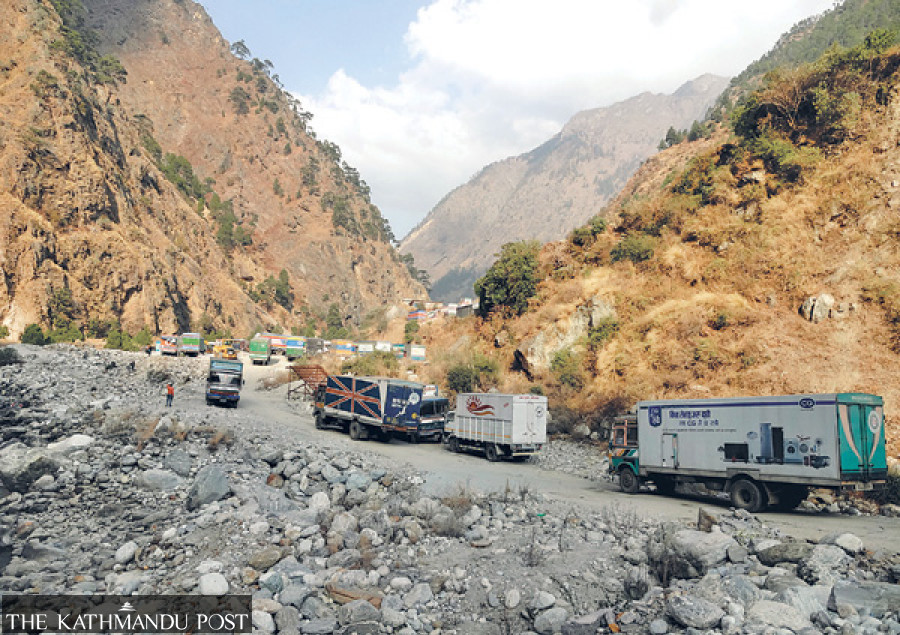Columns
Unpacking trade ties with China
Nepal trades more with distant economies like Italy and France than with its immediate neighbour China.
Prashanti Poudyal
Nepal’s trade with China resumed through the Rasuwagadhi checkpoint in December. The two busiest checkpoints on the northern border, Tatopani and Rasuwagadhi, had been non-functional for the past three years due to Covid-restrictions imposed by China. While Covid-19 was a major catalyst, one can’t help but notice Nepal’s declining trade with China over the years. Today, Nepal trades more with distant economies like Italy and France than it does with China. Last year, Nepal’s trade deficit with China increased to Rs263.97 billion. While there are numerous agreements with China in place, their effectiveness is hardly seen on the ground, as the core problems remain neglected.
Nepal has long felt the need to diversify its trade rather than relying solely on India. The need was reinforced by the unofficial blockade of Nepal’s southern border points in 2015. Nepal had to import oil along with other essential products from China. This led to the signing of an oil trade deal with China in October 2015 in a bid to end the monopoly of Indian Oil Corporation in the Nepali market. Nepal then signed the Transit and Transport Agreement (TTA) with China in 2016 and China’s Belt and Road Initiative (BRI) in 2017. Trade is one among the five major components of the BRI.
Irrelevant agreement
A free trade agreement (FTA) is an agreement between two or more nations to eliminate or reduce tariff barriers on imports and exports. But for Nepal, like many least-developed countries (LDCs), non-tariff barriers are more of a hindrance. Non-tariff barriers aside, the FTA between Nepal and China could be detrimental to Nepal’s economy. As per a study done by the Centre for Social Inclusion and Federalism, China provided an economic analysis predicting a 4.8 percent increase in GDP if Nepal were to move forward with the FTA. Nepal’s Ministry of Industry, Commerce and Supplies then conducted an economic analysis of its own which instead showed a decline in GDP by 0.24 percent. The said report was forwarded to China with a proposal to sit for a meeting to discuss it. However, there has been no response from the Chinese counterpart as of yet.
Even if the FTA with China could help Nepal’s trade, the impact would only be marginal. This is because, as per its commitment to the World Trade Organisation, China has already extended 98 percent of its tariff line on duty-free quota-free to all LDCs, including Nepal. This means Nepal would only have an additional 2 percent to optimise from. While 8,000 products fall under China’s duty-free quota-free, Nepal has requested for an additional 495 products that it has been exporting to China.
Nepal and China have several agreements in place, with little to no effect seen on the ground. A glaring example is the Nepal-China Transit Transport Agreement, signed in 2016 with big promises of ending Nepal’s over-reliance on India. However, the agreement has been in limbo ever since. The Nepal-China Transit Transport Agreement was touted as a “geopolitical gamechanger for Nepal” as it was Nepal’s response to India’s months-long ‘unofficial’ border blockade after the promulgation of Nepal’s new constitution. In 2019, Nepal and China also signed the Transit Transport Agreement implementation protocol, which meant Nepal could use seven Chinese sea and land ports for third-country trade. Now, seven years after the signing of the agreement and four years since the signing of the protocol, not a single consignment from any third country has been received by Nepal via China under the agreement.
The Transit Transport Agreement, in retrospect, seems to be more of a political gimmick and geostrategic signalling to our southern neighbour. In any case, the routes and provisions outlined in it cannot serve as substitutes for trade routes with India or trade with India as a whole. Furthermore, unclear modalities and procedures seem to be major hindrances affecting the implementation of the agreement. Several provisions, including the detailed modality of cargo movement, its movement from Chinese ports towards the Nepal-China border, the real operational modality for the movement of cargo, processes involved at Chinese sea ports, delivery of imports and consignments from East Asia to Nepal, and the terms and conditions of the agreement, are yet to be discussed. All such modalities and procedures were provisioned to be negotiated through future bilateral consultative meetings and negotiations. However, these meetings have never been held.
Way forward
Although China is an important trading partner of Nepal, exports to the northern neighbour have been minimal over the years. In the fiscal year 2021-22, exports to China slipped to the 12th position. In fact, Nepal has exported more to distant economies like Italy, France, Canada and Japan in comparison to China, its immediate neighbour.
To overcome this, it becomes important to understand the main reasons for Nepal’s high trade deficit with China. Nepal’s lack of competitiveness coupled with non-tariff barriers is one. Low investment in the productive sector, particularly in manufacturing, which has resulted in a low volume of exportable surplus, is another. The focus now should be on addressing these underlying problems first. The Transit Transport Agreement’s ineffectiveness and the Nepal-China BRI agreement’s failing to gain traction necessitates the same. As a friendly neighbour, China should show flexibility in allowing Nepal to access its seaports. Further, China should refrain from unilaterally opening and closing the border as it has been doing over the years.




 16.12°C Kathmandu
16.12°C Kathmandu















